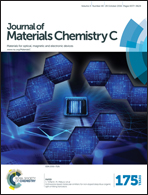Melanin-based flexible supercapacitors†
Abstract
Biocompatible and biodegradable materials that store electrochemical energy are attractive candidates for applications in bioelectronics and electronics for everywhere. Eumelanin is a ubiquitous biopigment in flora and fauna. It exhibits strong broad-band UV-visible absorption, metal chelation as well as good thermal and photo-stability. Eumelanin is based on 5,6-dihydroxyindole (DHI) and 5,6-dihydroxyindole carboxylic acid (DHICA) building blocks, present in different redox forms (hydroxyquinone, semiquinone and quinone). The synergy between the redox activity of the building blocks and the capability of several of their functionalities to reversibly bind cations constitutes the foundation for the use of melanin in pseudocapacitive energy storage systems. In this work, we report on the energy storage properties of eumelanin in supercapacitor configuration. Initially, a gravimetric specific capacitance as high as 167 F g−1 (specific capacity of 24 mA h g−1) was observed for eumelanin on carbon paper electrodes, in aqueous electrolytes. A maximum power density of up to 20 mW cm−2 was deduced for the corresponding melanin supercapacitors. Capitalizing on these results, we used an unconventional patterning approach to fabricate binder-free flexible micro-supercapacitors on plastic substrates. Our results demonstrate that melanin is a valid candidate for future supercapacitor electrodes. The biocompatibility and biodegradability featured by eumelanin, combined with its easy availability and room temperature processing, make it an extremely attractive material for environmentally and human friendly energy storage solutions.


 Please wait while we load your content...
Please wait while we load your content...